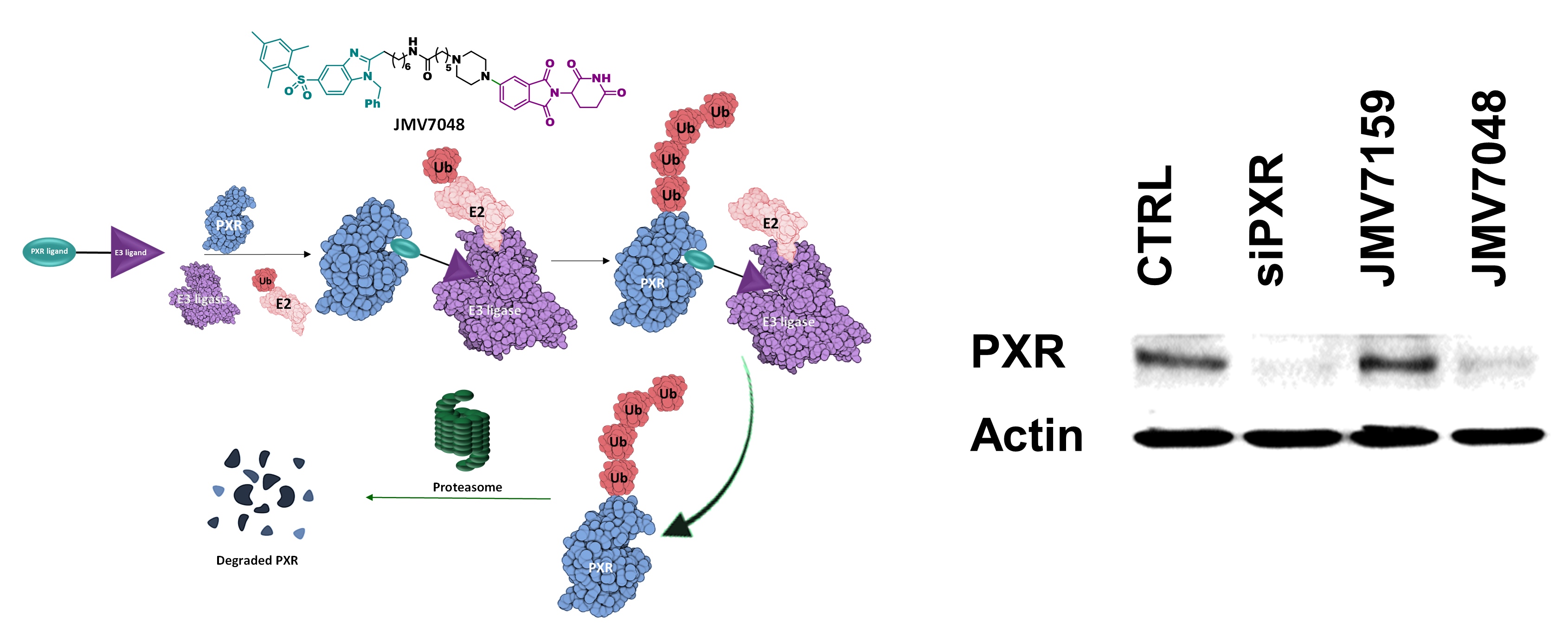WO2022243365 - BIFUNCTIONAL PROTAC-TYPE COMPOUNDS TARGETING PXR
UNE STRATÉGIE PROTAC (PROTEOLYSIS TARGETING CHIMERAS) POUR INHIBER L'EXPRESSION DE PXR DANS LES CELLULES SOUCHES CANCÉREUSES
Récepteur PXR et Chimiorésistance - Le récepteur nucléaire des xénobiotiques PXR est particulièrement difficile à inhiber par des stratégies de chimie médicinale conventionnelles. Pourtant son implication dans la dégradation de médicaments anticancéreux ainsi que dans la chimio-résistance et la progression de nombreux type de cancers en fait une cible thérapeutique très attractive. Après 4 années de recherche et la mise en place d’une approche chimique innovante ciblant la dégradation de PXR, une première famille de PROTACs (Proteolysis Targeting Chimera) a été développée avec succès conduisant à l’identification d’un PROTAC tête de série (JMV7048). Les PROTACs sont des molécules bifonctionnelles composées d’un ligand de la protéine cible et d’un ligand de recrutement de l’ubiquitine ligase E3, reliés par un espaceur chimique. Le PROTAC permet ainsi de rapprocher dans l’espace les deux protéines et d’induire l’ubiquitination de la protéine cible et par conséquent sa dégradation spécifique par le protéasome.
Ce projet de recherche issu d’une collaboration entre 4 instituts montpelliérains, l’IBMM (Muriel Amblard et Guillaume Laconde), l’IGF (Julie Pannequin et Jean-Marc Pascussi), le CBS (William Bourget et Vanessa Delfosse) et l’IRBM (Sabine Gerbal-Chaloin), a été soutenu par le CNRS valorisation, la SATT AxLR, l’UM et l’ANR. Les résultats obtenus ouvrent la voie à de nouvelles pistes thérapeutiques permettant de sensibiliser les cellules cancéreuses aux chimiothérapies et réduire la récidive tumorale. Ils ont donné lieu à un brevet.

Expression de la protéine PXR dans les cellules LS174T (carcinome colique) mesurée par Western blot 24h après transfection par 50nM d’un siRNA ciblant PXR (siPXR) ou traitements par les molécules JMV7048, JMV7159 (un dérivé non fonctionnel du JMV7048 ne permettant pas le recrutement de l’ubiquitine ligase CNBR), ou le solvant DMSO (CTRL).
...................................................................................................................................................................................................................................................................................................................................................................
A PROTAC (PROTEOLYSIS TARGETING CHIMERAS) STRATEGY TO INHIBIT PXR EXPRESSION IN CANCER STEM CELLS
PXR and Chemoresistance - Conventional medicinal chemistry strategies are particularly difficult to inhibit the nuclear xenobiotic receptor PXR. However, its role in the degradation of anticancer drugs, as well as chemoresistance and the progression of many types of cancer, makes it an appealing therapeutic target. A first family of PROTACs (Proteolysis Targeting Chimera) has been successfully developed after 4 years of research and the implementation of an innovative chemical approach targeting the degradation of PXR, leading to the identification of a lead PROTAC (JMV7048). PROTACs are bifunctional molecules that are linked by a chemical spacer and consist of a target protein ligand and an E3 ubiquitin ligase recruitment ligand. PROTAC allows the two proteins to interact in space and induce ubiquitination of the target protein, resulting in its specific degradation by the proteasome.
This study was conducted in collaboration with four Montpellier institutes: IBMM (Muriel Amblard and Guillaume Laconde), IGF (Julie Pannequin and Jean-Marc Pascussi), CBS (William Bourget and Vanessa Delfosse), and IRBM (Sabine Gerbal-Chaloin), and was funded by CNRS valorisation, SATT AxLR, UM, and ANR. The findings pave the way for new therapeutic approaches to sensitizing cancer cells to chemotherapies and reducing tumor recurrence. They resulted in a patent.

PXR protein expression in LS174T cells (colon carcinoma) measured by Western blot 24h after transfection with 50nM of a PXR-targeting siRNA (siPXR) or treatments with JMV7048, JMV7159 (a non-functional JMV7048 derivative that does not allow CNBR ubiquitin ligase recruitment ) or DMSO (solvent, CTRL)






